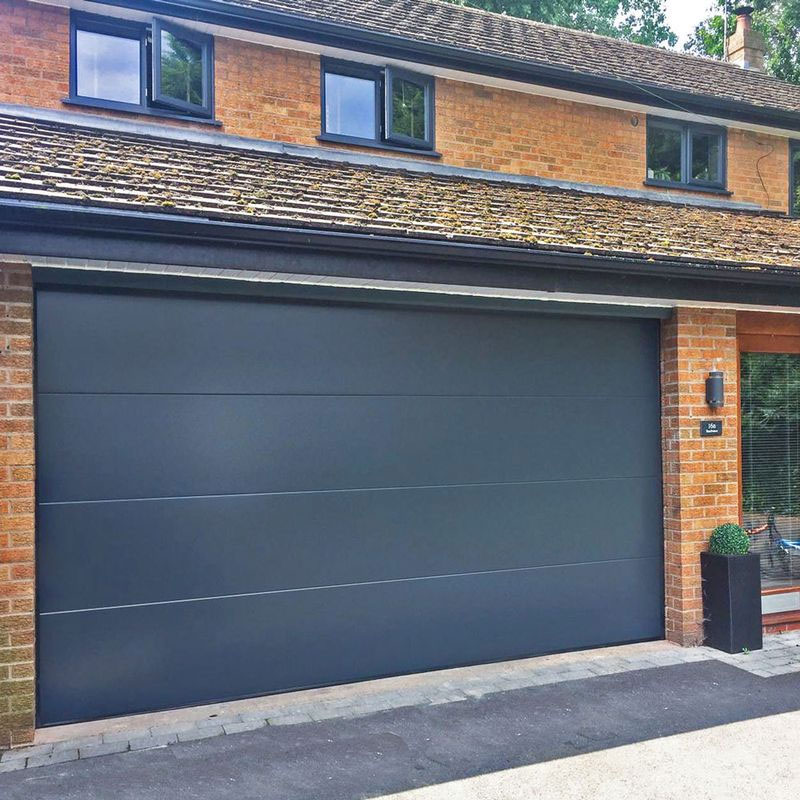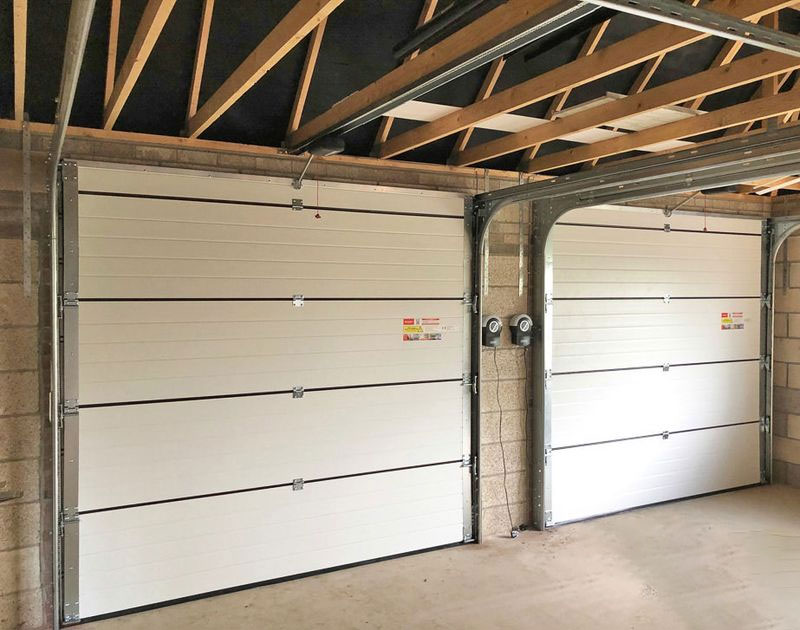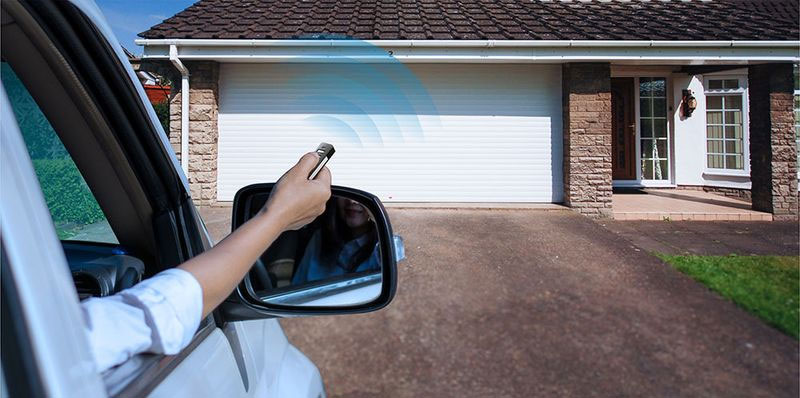Believe it or not, more goes into the buying process of a garage door. Amongst the size and price differences, garage doors come in different types too. So, which garage door should you choose for your property? Well, that’s why we’ve created this guide to help you answer that question. Ensuring you have a long-lasting solution that works well with your garage that looks good too.

Table of contents
- What is a garage door?
- How much does a garage door cost?
- Which garage door is best?
- What are standard garage door sizes?
- Can you insulate a garage door?
- What paint to use on a garage door
What is a garage door?
A garage door is a door that is used for, as the name suggests, garages. These doors can be large or small, depending on whether you plan to use them for simple privacy or storage or use them as an entrance and exit for your car.

How much does a garage door cost?
The cost of a garage door will depend on various factors, including material and labour costs. Thought you can expect the costs of garage doors to be anywhere between £750 to £9000. So before choosing what door you want to buy, consider the following:
- Operating style (manual or electric)
- Material (wood, metal or uPVC)
- Opening style (up and over, sectional, side hinged, roller or round the corner)
- Fitting (DIY or professional installation)
- Colour
- Size of the door (width and height)
- Subframe style
- Insulation (is it needed?)
How much is a fire door for a garage?
For the average garage fire door, this will depend on the material used, the labour costs and the rating of the fire door. Wooden garage doors, for example, can have lower costs than steel garage doors. However, their costs can rise because of the FD rating.
Fire regulations state that if your garage door is an internal door connecting to a house on a residential premise, this must be a fire door.
Which garage door is best?
Garage doors aren’t limited to one style. Here is a breakdown of the different types of doors and a summary of their key features.
| Type of garage door | Opening qualities | Features |
| 'Up and over' garage doors | •Opens in one solid section and over into the garage. •Electric and manual door options. •Tried and tested design mechanisms. •Canopy or retractable opening mechanism options. | •Typically, the easiest to install. •Considered the simplest to buy. •Weatherproof. •Variety of designs to choose from. •An array of colours. •Available in many different materials (wood, steel, plastic and fibreglass). •Made to order optional. •Can be built with a pedestrian door in the main door panel for entrance and exit. •Many locking points prevent intrusion. |
| Sectional garage doors | •Opens vertically, curving into the garage via horizontal rails. •Opens vertically to allow operation when parked up right against the door. | •Higher quality security. •Tough structure. •Top-quality insulative properties. •Ideal for short driveways. •Suited to garages with a maximum drive-through dimensions requirement. •Can be double-glazed. •Sizes available for large garages. |
| Side hinged (aka swing) garage doors | •Opens similarly to traditional double swing doors – outwards rather than upwards. •Can be automated on all types and sizes. | •Ideal if you use your garage for a car. •Insulative properties are suitable for garages used as rooms for storage or other. •Low maintenance •Easy to operate with open and close system. •Typically, easy to install, made even more so as a door set with a pre-fitted subframe. •Traditional appearance and style for classic aesthetics. •Quick access for pedestrian use. •Manufactured in various materials (softwood, hardwood, steel and GRP). |
| Roller garage doors | •Made up of slats, opens vertically, folding upwards and curling up into a roll above the entry point. •Primarily electric but manual closing is optional. •Optional side guides on some models help the door when descending. | •Ideal for garage spaces with little headroom. •Suitable for small garages or garages with obstructions. •Does not sacrifice security and insulation despite the curl-up mechanism. •Highly diverse – can be fitted inside, between or outside the garage opening. •Good insulative properties. |
| ‘Round-the-corner' garage doors | •Opens horizontally with a similar closing like roller or sectional doors but to the side rather than above. •Weight distribution is even to make the opening smooth and simple. | •Ideal for garage spaces with little headroom for other garage door types. •Partial opening allows access for pedestrians. •Suitable for larger openings. •Easy to maintain. •Offers a ‘barn door’ aesthetic. |
Example of a sectional door on the inside

Manual vs electric garage doors
Modern technology has made our lives much easier in many ways. That includes when dealing with garage doors. Although manual garage doors still exist, the option for electric garage doors allows more window of opportunity for ease of use and design.
‘Up and over’ doors are your likely candidate for manual systems. A simple lift of the door up into the garage roof space is an easy way to open it without hassle. A design that still has popularity today for its budget-friendly and familiarity with many homeowners. However, though original in design, they’re not known for long lifespans and aren’t ideal for heat retention. They’re also not the most secure. So, ensure you’re not planning to put any high-value items in the garage if you opt for this door.
Now this modern alternative, electric doors, offers more long-term usage and can be custom-built if you have a size requirement or colour in mind. This also enables more heat retention and improves security as there is less risk of the door being pried open. The main thing to consider with these is they’re on the expensive side. So, you’ll have to dig deep into your pockets if you decide to go ahead with this option.
Here’s a summary of the above:
Manual garage doors
| Pros | Cons |
| •Variety of colours to choose from. •Budget-friendly. •Can be installed with handles to open outward instead of upward. •Some models can be changed to electric in future if desired. •Can be easier to install. •Typically, won’t be affected during a power cut. | •Not as secure as electric with checks needed to ensure it is shut correctly when in use. •Will last for a few years before deterioration starts. •Easy to maintain until deterioration begins. •Can be a slower opening than electric. •Can be physically demanding to open. •Will need careful control to ensure safety when opening and closing. |
Electric garage doors
| Pros | Cons |
| •Variety of colours to choose from. •Higher security than manual with movement typically occurring only when the door is activated. •Long lifespan. •Little or no physical demand when opening and closing thanks to the remote control. •Typically, safer to use as a motion sensor can detect if there is an object blocking their way for opening or closing. •Can be built with a button or motion sensor control. •Can add value to the home as a technological benefit. | •More expensive than manual garage doors. •Difficult to maintain due to mechanisms as will most likely require professional and frequent repairs. •May not be able to open during a power cut. |

What are standard garage door sizes?
Standard garage door sizes are more in-depth than you think. Choosing the ‘standard size’ will depend on the type of garage door you want. Learn more about the different standard garage door sizes and explore our chart to shop for your ideal size.
Can you insulate a garage door?
Absolutely! If you find your garage door needs that little boost of insulation support, you can make some small adjustments to ensure its insulative properties are maximised. This can include sealing around a garage door or fitting a draught excluder. Either can be beneficial depending on your requirements. Our dedicated guides can explain more about how to fit these accessories.
What paint to use on a garage door
Recommended paints are typically the following (along with the door they’re normally used for):
- Oil-based paint (wood)
- Water-based paint (uPVC and wood)
- Multi-surface exterior paint (uPVC)
- Solvent-based metal paint (metal)
Although these paints can work well for exterior painting, researching the products you want to use is the best way to find the right paint for your garage door.
One of the first things you’ll want to do is make sure the paint you use is suitable for the outdoors. A paint that can last against the elements will make all the difference.
Secondly, ensure the paint can be used on the door material and spot sample test them with the colour(s) you want to use before painting the full door. That way you can avoid having to remove the paint or paint over the existing colour and risk poor-quality colour results.
Ideally, you’ll need to also prepare the door for painting before splashing on that luxury colour you desire. Using a primer can help prevent the risk of rust. If the paint is already self-primed, this can help save steps when painting the garage door.
Conclusion? It’s all about researching the paints before applying a full coat.

Want to know more about garage doors? Perhaps you have other door enquiries. If you need more information about different door-related products like hinges, you can check out our help and advice section for advice.















